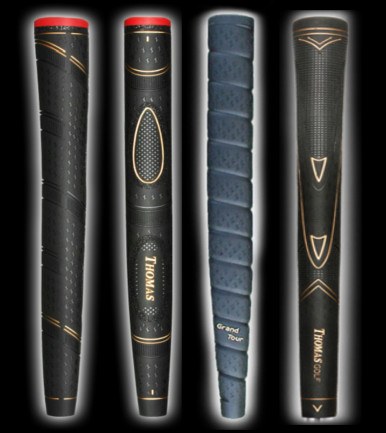
Golfers seldom notice the grips on their clubs unless the surface becomes slick or worn down. But the golf clubs grip's thickness can have a major impact on a club's performance – especially if it doesn't match the player's hands.
As a general rule, golfers with large hands should use thicker grips. (The converse is also true.) Grips that are too thin allow the hands too much freedom during the swing, often causing wild hooks. Overly large grips have the opposite effect, restricting hand movement and preventing a proper release through impact. The result: sliced or pushed shots.
There's also the matter of personal preference in golf grip size. Some golfers believe smaller grips deliver better feel and feedback, particularly on mishit shots and chipping around the greens. Others prefer the added control of a thicker grip.
Taking feel out of the equation, clubfitters may measure your hands to determine the best grip size. Factors like finger length, palm width and glove size are used to recommend grips of standard, small, midsize or oversize dimensions by companies like Thomas Golf.
It's been claimed that as many as nine of every 10 golfers play with grips of the wrong size. Getting yours right could provide an easy path to improvement.
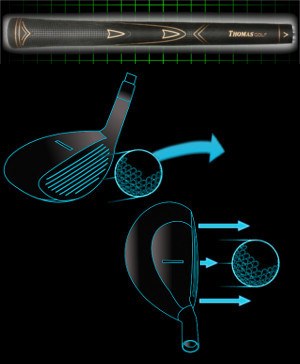
How Grip Size Affects Golf Club Performance
There are a number of variables to consider when thinking about the equipment you use on the golf course. You need to pick out a set of irons, you need to select a driver, a putter, some wedges, and more. All of those clubs need to have the right shafts, and you need to make sure you have a good bag and some shoes as well. For the beginning golfer, it can be rather overwhelming to learn all there is to learn about the topic of golf equipment.
In this article, we are going to look at yet another variable in the equipment discussion – grip size. This is a point that is overlooked or simply ignored by most golfers, as it just doesn't seem like it could make much of a difference. It does make a difference, however, as using the incorrect grip size for your hands and your swing could make the game much more difficult than it needs to be. As is the case with the rest of the variables in your set of clubs, you need to find the right grip size for you personally – it doesn't matter what other players use, as you are the one who will be swinging the clubs. Find the right grip size for your game and you will have another piece of the equipment puzzle in place.
How is it that grip size can play such an important role in the golf swing? It all comes down to the release. At impact, your hands should be moving aggressively through the ball in order to square the club face while delivering maximum speed. For your hands to work properly, the grip on your club needs to be the proper size. Having a grip which is either too thick or too thin will cause issues – we will get into the specifics of those issues later in the article. Also, aside from the problems that can be caused in the full swing, using the incorrect grip size will lead to trouble in your short game as well.
If you only have a small amount of experience in the game of golf, you might not have been aware previously that grips were available in various sizes. As you might expect, the most popular grip size is the 'standard' grip, which is what you will find on most clubs. There are a few other options to consider, however, depending on your needs. If you need to move up from a standard grip, you can move into a midsize or even a jumbo, which are thicker to accommodate players with large hands. Should a standard grip be too thick, some grip manufacturers offer an undersize or junior model.
In addition to picking out a specific grip size, you can also alter the thickness of your grips on the club by adding extra layers of tape at installation. A special tape is used to affix the grip to the shaft of the club, and you can opt for an additional layer of that tape simply for the purpose of providing a thicker feel. This is a great way to fine tune the size of your grips. For instance, if you need something thicker than standard but don't want to go all the way to a midsize, you can just add a couple layers of grip tape to establish the perfect fit.
All of the content below is based on a right-handed golfer. If you happen to play left-handed, please take a moment to reverse the directions as necessary.
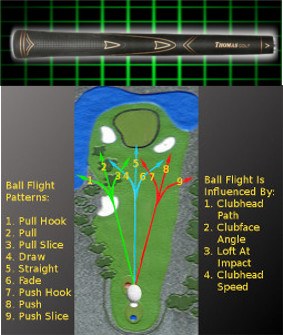
Signs of Trouble
The best way to determine if there is a problem with the size of your grips is to pay close attention to your game. Both on the range and on the course, pay close attention to the ball flights you produce and take note if anything seems 'out of place'. Specifically, watch for ball flights which are different from what you expect. In other words, if it seems like your swing should have produced a draw, but you look up to see the ball slicing to the right, there may be an equipment issue to solve. You certainly don't want to blame your equipment for all of your poor shots, but it is possible that your gear is getting in the way of better results.
Where some parts of the golf equipment puzzle can be rather complicated, things are pretty simple when it comes to grip size. The points below highlight what you can expect to see if you are using the wrong grip size on your clubs.
- Small grips promote a hook. When your grips are too small, it is likely that the ball is going to hook to the left. With small grips, your hands will have too much control over the club face through the hitting area, and the face is likely to be closed at impact as a result. Assuming you are swinging on a relatively straight path, that closed club face is going to lead to a right to left ball flight. Some of these shots might come off as draws which are playable, but most of them are likely to turn quickly to the left as big hooks. When the mechanics of your swing seem fine and you are still hitting a hook, take a close look at the size of your grips as a possible culprit.
- Large grips promote a slice. You probably won't be surprised to learn that using large grips is going to often lead to a slice. This situation is just the opposite from above. Rather than the club releasing too quickly through impact, the club will fail to release fully when your grips are too large for your hands. The club face will hang open through the hitting area, the ball will spin from left to right, and you will hit either a fade or a slice. In addition to the slicing trajectory, you will also lose significant distance when your grips are too large, as the lack of a proper release is going to rob you of swing speed. It is frustrating to play golf with grips that are too large, as you will feel as though you are doing everything correctly and yet the ball will not stay on target.
Beyond watching the ball flights you produce to look for a problem, you can simply pay attention to the way the clubs feel in your hands. Do the grips feel comfortable, or do they seem to be too small or too big? When you wrap your hands around the club, the middle finger on each hand should be able to just barely touch your palm. If there is a big gap between the end of your middle finger and the palm of your hand, your grips are too big. If your middle finger pushing into your palm, your grips are too small. Use this general guide, along with the information you are getting from your shots, in order to decide if new grips will be necessary.
If you still can't decide whether or not you need new grips, the best choice may be to head to a local golf shop for a quick fitting. Most golf stores have sample grips which you can try in order to find the right one for your hands. Ask the professional club fitter at the shop to help you with the process – he or she will know exactly what to look for when fitting a player for new grips. This is an important point, so it will pay off in the long run to take some time now to get it right.
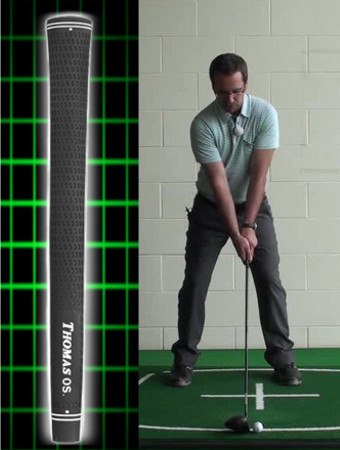
Making a Change
If you start paying more attention to your grip size in the rounds and practice sessions ahead, there is a reasonable chance that you will decide to make a switch. You may find that your current grips are doing the job just fine, but more likely you will determine there is a need for at least a minor adjustment. Fortunately, changing up the grips on your clubs is one of the easiest adjustments you can make to your equipment.
For most people, changing grips is going to mean taking your clubs in to a golf shop for assistance. It is possible to change your grips on your own – it isn't particularly difficult – but you need to have a few small pieces of equipment which are not possessed by the average golfer. Unless you are an avid player who plans on changing out grips regularly, it makes more sense to simply turn your clubs over to the local pro to have the job completed. If you purchase your grips at the shop that will be performing the work, most will do the grip change for no charge (or just a small fee).
At the time you drop your clubs off for grip replacement, be sure to specify any special requests you may have. In addition to telling the shop worker which grips you want placed on your clubs, you can tell them how many wraps of tape you would like, and even how you would like the grips oriented on the clubs. These are your clubs, after all, so make sure they come out exactly as you would like.
One thing that few golfers think about when re-gripping clubs is the fact that you don't have to have all of your clubs re-gripped in the same manner. For instance, if you have trouble turning your driver over from right to left, you may wish to set it up with a slightly thinner grip to promote a draw. Or, if you like to feel a thicker grip in your hands when playing short game shots, you could ask for extra tape to be used on your wedges. While you don't want dramatic variation from one club to the next, there is nothing at all wrong with a little customization along the way to set up your gear just right for your swing.
Once your new grips are installed, you should plan a trip to the driving range as soon as possible to get used to their new feel. Even if you now have properly sized grips in place, it is still going to take a bit of time before you see the results you expected. Any change in golf takes time, and that is especially true when the change is related to your feel for the club. If possible, try to complete at least two or three practice sessions at the range before making a tee time to take your new set onto the course.
With your new set of grips in place, you should take a few steps to keep them in good condition for as long as possible. Grips aren't free, of course, so protecting them with some simple maintenance will go a long way toward extending their life span. For one thing, you should get in the habit of wiping them down at the end of every round. Your hands are going to transfer oils and other substances onto the rubber during the course of a round, and a quick wipe off with a damp towel will clean up the surface nicely. Also, consider doing a more thorough cleaning once every few rounds where you use some soapy water and a gentle brush. Always dry your grips completely after wiping them down, and store your clubs in a dry place. Given the cost of golf equipment, taking a few moments to keep your clubs clean is an investment which will pay off in the long run.
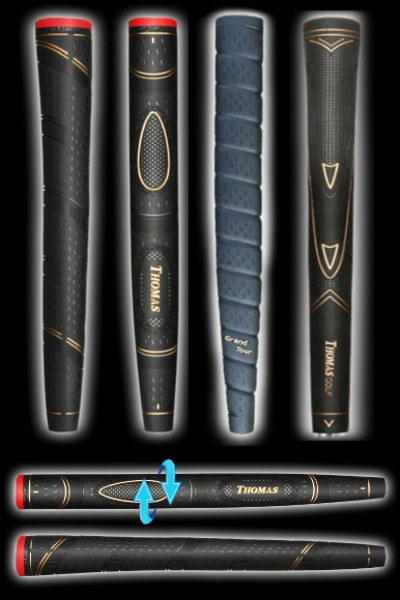
Picking Your Grips
In addition to figuring out what size grips will be best for your needs, you also have to pick out which model of grips you will install on your clubs. The majority of the grips on the market today will look pretty much the same from a distance, but there is significant variety within the selection when you look a little closer. There is no right or wrong when it comes to picking out the type of grips you are going to use – this is a point that comes down to your own feel and personal preference.
Some of the decisions you will need to make are highlighted below.
- Firm or soft. One of the biggest variations you will see in golf grips is the difference between firm grips and softer models. As far as feel goes, this is a key point which you will need to decide on before making a purchase. Soft grips feel comfortable in your hands, and they are unlikely to lead to blisters. However, some golfers feel that they lose a bit of control over the club head when they play with a soft grip. On the other side of the coin, firm grips are far less forgiving, and your skin is likely to pay the price. Unless you have tough hands from years of playing a lot of golf, firm grips will likely lead to at least a couple of blisters. However, if you are willing to sacrifice a little skin, you can benefit in the way of added control. Most professional golfers use grips which come in on the firm side of the scale because of the control and precision they provide.
- Corded or plain. In golf grip parlance, 'cords' refer to strips of fabric which are woven into the design of the grip. This material is embedded within the rubber itself, and it will remain there (hopefully) for as long as you use your grips. Corded grips provide the ultimate in control, as the friction between your hands and the grips themselves will be maximized. For players with sweaty hands, or for players who frequently golf in the rain, corded grips make a lot of sense. So what is the drawback? Simple – these kinds of grips can shred the skin on your hands, especially if you play infrequently. Regular golfers will build up callouses to protect their hands against damage, but that isn't going to happen if you only play once or twice per month. For the typical golfer, corded grips will do damage after just a few holes. If you do decide to opt for cords, remember to keep some skin care and protection products in your bag. These grips certainly let you control the club, but that control comes at a price.
- Color. Okay – so this point isn't all that important, but it is a decision you will need to make anyway. While golf grips have traditionally been black with maybe a bit of white lettering, today you can find grips in a wide range of colors. While the color of your grips will have nothing at all to do with their performance, you may wish to liven up your bag by picking a loud color. White grips are easy to find these days, as are other shades such as red, green, and more.
If you take a trip to a local golf store, you should find a large selection of grips to pick from. Of course, while you are shopping, pay close attention to the prices as well, as some grips will cost more than twice as much as others. They might not look expensive while you examine different models on the shelf, but remember you need to multiply that price by 13 in order to grip all of your clubs (minus the putter). If you pay attention to sales at the end of the golfing season, you might be able to get a great deal on some quality grips.

Short Game Considerations
The way you release the club in the full swing is going to be impacted by the size of the grips you place on your clubs. However, the impact of your grip size does not stop with the long game. The short game is to be considered as well, as you need to have a great feel for your wedges when trying to get up and down from around the greens.
For most people, it is going to be better to lean toward thicker grips when setting up wedges. You don't need an aggressive release when playing wedge shots from the fairway, and chipping with your wedges will be a bit easier with more grip in your hands. Grips which are too small for the player can lead to excessive hand action in the chipping motion – and that is never a good thing. To keep your hands quiet through the ball while chipping, consider placing larger grips on your wedges than on the rest of your clubs.
Before we finish, it is worth mentioning the topic of putter grips. This is the only grip in your bag which will be flat on one side, as putter grips feature a flat top to allow your thumbs to rest comfortably. The task of picking out a putter grip comes down to personal preference more than anything else. You don't have to worry about issues like blisters since you won't be making full swings with your putter, and friction isn't much of a concern either. Thick putter grips have become popular in recent years because of the way they take the hands out of the stroke, but there are plenty of players who putt well with thinner grips as well. Experiment with a couple different options before settling on the grip which will lead you to make more putts.
Grip size might seem like a trivial topic in the big scheme of things, but it is important if you wish to optimize your game. Playing with grips which are either too large or too small can make it difficult to control your ball flights successfully. Think about any problems you are having with your game currently and consider the possibility of using a grip size adjustment to get yourself back on track. With the right grips in your hands you will be free to make quality swings, knowing the results are not going to be affected by incorrect grips. Good luck!






